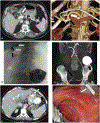Hepatic Artery Infusion Pumps: A Surgical Toolkit for Intraoperative Decision-Making and Management of Hepatic Artery Infusion-Specific Complications
- PMID: 36346892
- PMCID: PMC9700364
- DOI: 10.1097/SLA.0000000000005434
Hepatic Artery Infusion Pumps: A Surgical Toolkit for Intraoperative Decision-Making and Management of Hepatic Artery Infusion-Specific Complications
Abstract
Background: Hepatic artery infusion (HAI) is a liver-directed therapy that delivers high-dose chemotherapy to the liver through the hepatic arterial system for colorectal liver metastases and intrahepatic cholangiocarcinoma. Utilization of HAI is rapidly expanding worldwide.
Objective and methods: This review describes the conduct of HAI pump implantation, with focus on common technical pitfalls and their associated solutions. Perioperative identification and management of common postoperative complications is also described.
Results: HAI therapy is most commonly performed with the surgical implantation of a subcutaneous pump, and placement of its catheter into the hepatic arterial system for inline flow of pump chemotherapy directly to the liver. Intraoperative challenges and abnormal hepatic perfusion can arise due to aberrant anatomy, vascular disease, technical or patient factors. However, solutions to prevent or overcome technical pitfalls are present for the majority of cases. Postoperative HAI-specific complications arise in 22% to 28% of patients in the form of pump pocket (8%-18%), catheter (10%-26%), vascular (5%-10%), or biliary (2%-8%) complications. The majority of patients can be rescued from these complications with early identification and aggressive intervention to continue to deliver safe and effective HAI therapy.
Conclusions: This HAI toolkit provides the HAI team a reference to manage commonly encountered HAI-specific perioperative obstacles and complications. Overcoming these challenges is critical to ensure safe and effective pump implantation and delivery of HAI therapy, and key to successful implementation of new programs and expansion of HAI to patients who may benefit from such a highly specialized treatment strategy.
Copyright © 2022 Wolters Kluwer Health, Inc. All rights reserved.
Conflict of interest statement
The authors report no conflict of interests.
Figures






Comment in
-
Hepatic Arterial Infusion Pump: Quo Vadis?Ann Surg. 2022 Dec 1;276(6):957-958. doi: 10.1097/SLA.0000000000005580. Epub 2022 Jul 15. Ann Surg. 2022. PMID: 35837950 No abstract available.
References
-
- Kemeny NE, Niedzwiecki D, Hollis DR, et al. Hepatic arterial infusion versus systemic therapy for hepatic metastases from colorectal cancer: a randomized trial of efficacy, quality of life, and molecular markers (CALGB 9481). J Clin Oncol. 2006;24:1395–1403. - PubMed
-
- Dhir M, Jones HL, Shuai Y, et al. Hepatic arterial infusion in combination with modern systemic chemotherapy is associated with improved survival compared with modern systemic chemotherapy alone in patients with isolated unresectable colorectal liver metastases: a case-control study. Ann Surg Oncol. 2017;24:150–158. - PubMed
Publication types
MeSH terms
Grants and funding
LinkOut - more resources
Full Text Sources
Medical

